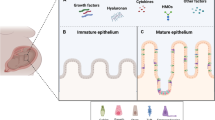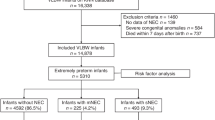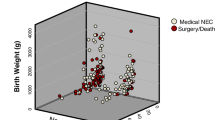Abstract
Objective
Identify early neonatal and maternal risk factors for development of necrotizing enterocolitis (NEC) in preterm infants receiving an exclusive human milk diet (EHMD).
Study design
Preterm infants who developed NEC stage ≥2 while receiving an EHMD were compared to matched controls who did not develop NEC on the same diet. Predictors of NEC were selected for multiple-predictor logistic regression analysis based on literature or significance in single-predictor models.
Results
A total of 27 cases and 98 controls (mean GA = 27 weeks) were included. Groups did not differ significantly on baseline characteristics. Maternal urinary tract infection, maternal neutrophil-to-lymphocyte ratio before delivery, and vasopressor use during the first week significantly predicted NEC.
Conclusion
Despite the use of EHMD, NEC remains a concern, underlining its multifactorial nature. Results highlight the potential role of maternal inflammation and early neonatal hemodynamic instability in NEC development. Findings could inform future research aimed at identifying high-risk infants.
This is a preview of subscription content, access via your institution
Access options
Subscribe to this journal
Receive 12 print issues and online access
$259.00 per year
only $21.58 per issue
Buy this article
- Purchase on SpringerLink
- Instant access to full article PDF
Prices may be subject to local taxes which are calculated during checkout

Similar content being viewed by others
Data availability
The datasets generated during and/or analyzed during the current study are available from the corresponding author on reasonable request.
References
Alsaied A, Islam N, Thalib L. Global incidence of Necrotizing Enterocolitis: a systematic review and Meta-analysis. BMC Pediatr. 2020;20:344.
Caplan MS, Underwood MA, Modi N, Patel R, Gordon PV, Sylvester KG, et al. Necrotizing enterocolitis: using regulatory science and drug development to improve outcomes. J Pediatr. 2019;212:208–15.e1.
Jones IH, Hall NJ. Contemporary outcomes for infants with necrotizing enterocolitis—a systematic review. J Pediatr. 2020;220:86–92.e3.
Markel TA, Martin CA, Chaaban H, Canvasser J, Tanner H, Denchik H, et al. New directions in necrotizing enterocolitis with early-stage investigators. Pediatr Res. 2020;88:35–40.
Bautista GM, Cera AJ, Chaaban H, McElroy SJ. State-of-the-art review and update of in vivo models of necrotizing enterocolitis. Front Pediatr. 2023;11:1161342.
Bazacliu C, Neu J. Necrotizing enterocolitis: long term complications. Curr Pediatr Rev. 2019;15:115–24.
Grace E, Hilditch C, Gomersall J, Collins CT, Rumbold A, Keir AK. Safety and efficacy of human milk-based fortifier in enterally fed preterm and/or low birthweight infants: a systematic review and meta-analysis. Arch Dis Child Fetal Neonatal Ed. 2021;106:137–42.
Ananthan A, Balasubramanian H, Rao S, Patole S. Human milk-derived fortifiers compared with bovine milk-derived fortifiers in preterm infants: a systematic review and meta-analysis. Adv Nutr. 2020;11:1325–33.
Premkumar MH, Pammi M, Suresh G. Human milk-derived fortifier versus bovine milk-derived fortifier for prevention of mortality and morbidity in preterm neonates. Cochrane Database Syst Rev. 2019;2019:CD013145.
Sullivan S, Schanler RJ, Kim JH, Patel AL, Trawöger R, Kiechl-Kohlendorfer U, et al. An exclusively human milk-based diet is associated with a lower rate of necrotizing enterocolitis than a diet of human milk and bovine milk-based products. J Pediatr. 2010;156:562–7.e1.
Monzon N, Kasahara EM, Gunasekaran A, Burge KY, Chaaban H. Impact of neonatal nutrition on necrotizing enterocolitis. Seminars Pediatr Surg. 2023;32:151305.
Jensen GB, Domellöf M, Ahlsson F, Elfvin A, Navér L, Abrahamsson T. Effect of human milk-based fortification in extremely preterm infants fed exclusively with breast milk: a randomised controlled trial. EClinicalMedicine. 2024;68:102375.
Galis R, Trif P, Mudura D, Mazela J, Daly MC, Kramer BW, et al. Association of fortification with human milk versus bovine milk-based fortifiers on short-term outcomes in preterm infants-a meta-analysis. Nutrients. 2024;16:910.
Been JV, Lievense S, Zimmermann LJ, Kramer BW, Wolfs TG. Chorioamnionitis as a risk factor for necrotizing enterocolitis: a systematic review and meta-analysis. J Pediatr. 2013;162:236–-42.e2.
Duci M, Frigo AC, Visentin S, Verlato G, Gamba P, Fascetti-Leon F. Maternal and placental risk factors associated with the development of necrotizing enterocolitis (NEC) and its severity. J Pediatr Surg. 2019;54:2099–102.
Jain VG, Willis KA, Jobe A, Ambalavanan N. Chorioamnionitis and neonatal outcomes. Pediatric Res. 2022;91:289–96.
Su Y, Xu R-H, Guo L-Y, Chen X-Q, Han W-X, Ma J-J, et al. Risk factors for necrotizing enterocolitis in neonates: a meta-analysis. Front Pediatr. 2023;10:1079894.
Janevic T, Zeitlin J, Auger N, Egorova NN, Hebert P, Balbierz A, et al. Association of race/ethnicity with very preterm neonatal morbidities. JAMA Pediatr. 2018;172:1061–9.
Jammeh ML, Adibe OO, Tracy ET, Rice HE, Clark RH, Smith PB, et al. Racial/ethnic differences in necrotizing enterocolitis incidence and outcomes in premature very low birth weight infants. J Perinatol. 2018;38:1386–90.
Walsh MC, Kliegman RM. Necrotizing enterocolitis: treatment based on staging criteria. Pediatr Clin North Am. 1986;33:179–201.
Hennessy S, Bilker WB, Berlin JA, Strom BL. Factors influencing the optimal control-to-case ratio in matched case-control studies. Am J Epidemiol. 1999;149:195–7.
Lee JY, Park KH, Kim A, Yang HR, Jung EY, Cho SH. Maternal and placental risk factors for developing necrotizing enterocolitis in very preterm infants. Pediatr Neonatol. 2017;58:57–62.
Lee JH, Park CW, Moon KC, Park JS, Jun JK. Neutrophil to lymphocyte ratio in maternal blood: a clue to suspect amnionitis. J Clin Med. 2021;10:2673.
Simovic A, Kuc A, Jevtic E, Kocovic A, Markovic S, Stanojevic M, et al. Can early hyperglycemia affect the morbidity/mortality of very low birth weight premature infants?. Turk J Pediatr. 2021;63:482–9.
Fenton TR, Griffin IJ, Hoyos A, Groh-Wargo S, Anderson D, Ehrenkranz RA, et al. Accuracy of preterm infant weight gain velocity calculations vary depending on method used and infant age at time of measurement. Pediatric Res. 2019;85:650–4.
Morgan J, Bombell S, McGuire W. Early trophic feeding versus enteral fasting for very preterm or very low birth weight infants. Cochrane Database Syst Rev. 2013;2013:Cd000504.
Shah DD, Kuzmov A, Clausen D, Siu A, Robinson CA, Kimler K, et al. Osmolality of commonly used oral medications in the neonatal intensive care unit. J Pediatr Pharm Ther. 2021;26:172–8.
Harris PA, Taylor R, Thielke R, Payne J, Gonzalez N, Conde JG. Research electronic data capture (REDCap)-a metadata-driven methodology and workflow process for providing translational research informatics support. J Biomed Inf. 2009;42:377–81.
R Stats Package. 2020. https://stat.ethz.ch/R-manual/R-devel/library/stats/html/glm.html.
Wickham H. Programming with ggplot2. ggplot2: elegant graphics for data analysis. Cham: Springer International Publishing; 2016. p. 241–53.
Wolf MF, Rose AT, Goel R, Canvasser J, Stoll BJ, Patel RM. Trends and racial and geographic differences in infant mortality in the United States due to necrotizing enterocolitis, 1999 to 2020. JAMA Netw Open. 2023;6:e231511–e.
Samuels N, van de Graaf RA, de Jonge RCJ, Reiss IKM, Vermeulen MJ. Risk factors for necrotizing enterocolitis in neonates: a systematic review of prognostic studies. BMC Pediatr. 2017;17:105.
Cotten CM. Modifiable risk factors in necrotizing enterocolitis. Clin Perinatol. 2019;46:129–43.
Essex C, Hegedus C, Vincent K, Shiflett A, Rohrer A, Chetta KE. Maternal, neonatal, and nutritional risk factors for medical and surgical necrotizing enterocolitis. J Perinatol. 2024;44:1762–7.
Humberg A, Fortmann I, Siller B, Kopp MV, Herting E, Göpel W, et al. Preterm birth and sustained inflammation: consequences for the neonate. Semin Immunopathol. 2020;42:451–68.
Kumar S, Plakkal N, Keepanasseril A. Effect of maternal antibiotics on preterm neonatal outcomes: a retrospective cohort study. Indian J Pediatr. 2024;91:628.
Youn YA, Kim E-K, Kim SY. Necrotizing enterocolitis among very-low-birth-weight infants in Korea. J Korean Med Sci. 2015;30:S75–S80.
Hundscheid T, Onland W, Kooi EMW, Vijlbrief DC, de Vries WB, Dijkman KP, et al. Expectant management or early ibuprofen for patent ductus arteriosus. N Engl J Med. 2023;388:980–90.
Hamrick SEG, Sallmon H, Rose AT, Porras D, Shelton EL, Reese J, et al. Patent ductus arteriosus of the preterm infant. Pediatrics. 2020;146:e20201209.
Mehta R, Petrova A. Biologically active breast milk proteins in association with very preterm delivery and stage of lactation. J Perinatol. 2011;31:58–62.
Nolan LS, Rimer JM, Good M. The role of human milk oligosaccharides and probiotics on the neonatal microbiome and risk of necrotizing enterocolitis: a narrative review. Nutrients. 2020;12:3052.
Saben JL, Sims CR, Abraham A, Bode L, Andres A. Human milk oligosaccharide concentrations and infant intakes are associated with maternal overweight and obesity and predict infant growth. Nutrients. 2021;13:446.
Author information
Authors and Affiliations
Contributions
Haider Ailumerab contributed to the conceptualization of the project, data collection, contributed to data analysis, and drafted the initial manuscript. Jamie Miller provided guidance on pharmaceutical aspects of the study and assisted with writing, critically reviewing, and revising the manuscript. Lise DeShea advised on statistical analyses, oversaw the database and secure data storage, analyzed the data, and assisted with writing and revising the manuscript. William Howard Beasley advised on statistical analyses, analyzed the data, created data visualizations, and assisted with writing the manuscript. Hala Chaaban contributed to the conceptualization, methodology, and data analysis, and provided critical revisions of the manuscript. Erynn M. Bergner contributed to the conceptualization and methodology, supervision of the project, and critically revised the manuscript. All authors approved the final manuscript as submitted and agreed to be accountable for all aspects of the work.
Corresponding author
Ethics declarations
Competing interests
The authors have no conflicts of interest relevant to this article to disclose. EMB previously served as the Site PI for Prolacta Biosciences® unrelated trial on infants with congenital bowel disorders (2019-2023) for which the institution received research support. The other authors have no conflicts of interest to disclose.
Additional information
Publisher’s note Springer Nature remains neutral with regard to jurisdictional claims in published maps and institutional affiliations.
Supplementary information
Rights and permissions
Springer Nature or its licensor (e.g. a society or other partner) holds exclusive rights to this article under a publishing agreement with the author(s) or other rightsholder(s); author self-archiving of the accepted manuscript version of this article is solely governed by the terms of such publishing agreement and applicable law.
About this article
Cite this article
Ailumerab, H., Miller, J.L., DeShea, L. et al. Risk factors associated with the development of necrotizing enterocolitis in preterm infants on an exclusive human milk diet: a single-center case-control study. J Perinatol (2025). https://doi.org/10.1038/s41372-025-02401-2
Received:
Revised:
Accepted:
Published:
DOI: https://doi.org/10.1038/s41372-025-02401-2



